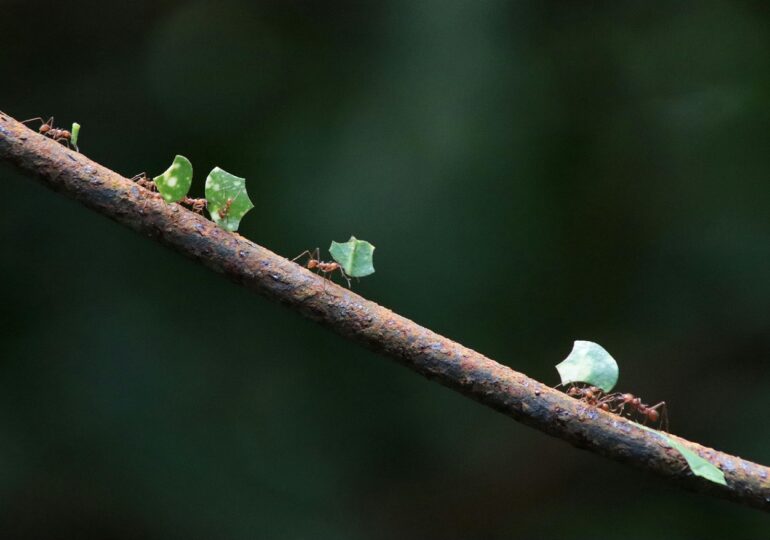Humanity rightfully prides itself on its greatest achievements – agriculture, medicine, engineering, and the construction of civilizations. However, remarkably, ants mastered these innovations millions of years before us.
Let’s consider a situation where you helped someone move a heavy object, like a sofa. Although the task initially seemed quite simple, it actually required a series of advanced behaviors.
Verbal commands were needed for coordination („turn around!”) and anticipating events in the near future (moving other pieces of furniture to make space). Additionally, a clear and common vision of the final objective was necessary (which room to move the sofa to).
It’s a small but satisfying example of human cooperation. However, before we pride ourselves, let’s consider that ants – creatures with tiny brains and no speaking ability – routinely achieve feats that rival and sometimes surpass ours, notes The Conversation. We have much to learn from these social insects.
### Incursion into the Ant World
The Earth is literally teeming with ants. Scientists estimate that there are at least 20,000 trillion ants on Earth. That’s a 20 followed by 15 zeros. That’s more ants than stars in our galaxy, the publication writes.
These incredible insects are among the most successful organisms on the planet. Part of their success comes from their ability to form complex societies, from a few individuals to millions. And these societies, or colonies, are remarkably cooperative.
– [A group of ants outperformed humans in a maze test](https://spotmedia.ro/stiri/magazin-si-stiinta/un-grup-de-furnici-a-surclasat-oamenii-la-testul-labirintului)
Take, for example, the abilities of ants to move large food items. To do this, they mobilize teams of tens – or even hundreds – of workers. They act efficiently together to transport the load into the anthill.
Crazy ants with long horns (Paratrechina longicornis) are also known for removing debris from the path before moving a heavy object, anticipating its trajectory and preparing the way. Humans, on the other hand, work more complicatedly – they need approvals, orders, and… money. And sometimes, even that doesn’t get the job done right.
An experiment pitted crazy ants with long horns against humans, all tasked with moving T-shaped objects (adapted to their body size) through narrow spaces. In some tests, human teams were not allowed to speak or use gestures.
The result? Ants performed better in larger groups compared to smaller ones, demonstrating the clear benefits of collective action. In contrast, human performance did not improve with group size. And when communication was restricted, human performance decreased as the group size increased.
All of these highlight how ants rely on collective intelligence without the need for central control or sophisticated knowledge.
### Experienced Little Farmers
The emergence of agriculture, 12,000 years ago, is rightly considered one of humanity’s greatest achievements.
However, leafcutter ants beat us to it. These leafcutter ants (from the species Atta and Acromyrmex) have evolved to practice large-scale agriculture about 55 million years ago. They cut and transport fresh leaves not to eat directly but to feed a fungus that serves as their main food source.
This evolutionary partnership allows ants to feed colonies with populations of millions.
– [Behavior observed for the first time in an ant colony](https://spotmedia.ro/stiri/magazin-si-stiinta/comportament-in-premiera-observat-la-o-colonie-de-furnici)
Remarkably, leafcutter ants have also developed a form of biological pest control to protect their crops from bacteria. Some worker ants patrol the gardens, detecting infected sections of the fungus. They then apply antibiotics produced by bacteria living on their bodies.
Moreover, many ant species raise aphids (insects like small plant lice) and other insects that feed on plant sap and excrete a sugary liquid that ants eagerly collect. In return, ants serve as bodyguards, defending their small animals from predators like ladybugs and leaf beetles.
### Ant Medicines
Medical care may seem like a distinctly human innovation. However, several ant species have developed sophisticated methods for treating wounds.
If a Florida carpenter ant (Camponotus floridanus) is injured during a battle between colonies, its anthill colleagues amputate a damaged limb to prevent infection spread. Ants receiving this care on the battlefield have a higher chance of survival than those left untreated.
Some ants can detect infections and treat infected wounds by cleaning them and applying antimicrobial secretions from specialized glands.
### Master Builders
Some ant species are known for literally putting their bodies in danger to defend the colony.
Army ants (Eciton burchellii) join their bodies to form structures. These include bridges over gaps on the forest floor and improvising living „scaffolds” on steep terrain to prevent other ants from slipping.
– [Ant trafficking network annihilated in Kenya](https://spotmedia.ro/stiri/eveniment/retea-de-traficanti-de-furnici-anihilata-in-kenya)
Even the anthill consists of hundreds of thousands of ants staying united, along with tunnels and underground chambers housing larvae and the queen. The entire structure is reinforced and rebuilt every day after the colony migrates a few hundred meters in the forest.
Meanwhile, weaver ants (Oecophylla smaragdina) unite and form living ropes to overcome vertical gaps. They also form a line of worker ants that pull leaves together at the tops of trees to form nests. When the leaves are in place, other ants arrive with ant larvae in their jaws. Each larva produces a small silk spot that the ants use to stick the leaves together.
Fire ants (Solenopsis invicta), a major pest species, partially owe their invasive success to a unique dispersal method. When their underground nests are flooded by rain, the ants gather and form a huge raft that floats on a layer of floating larvae. These rafts can safely navigate floodwaters for hundreds of kilometers until they reach dry land.
### Lessons for Humanity
People take pride in their greatest achievements – agriculture, medicine, engineering, and the construction of civilizations. But ants mastered these innovations millions of years before us.
They may be tiny, but working together, ants can build complex societies and solve many problems. And they might just teach humans a thing or two in many aspects, such as solidarity, communication, discipline, ingenuity, and resilience.
T.D.

